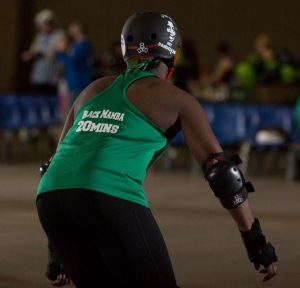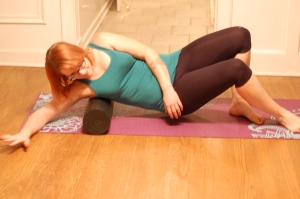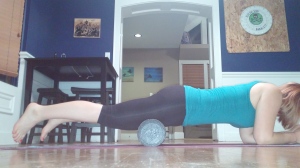by Jade Bond
Foam rolling—what the heck is it and why should I do it? Have you ever been so sore it hurts to just be alive? Want to learn how to soothe your sore derby-tired muscles and prevent injuries? I have a secret to share with you—foam rolling is your friend! Not only does it work out soreness post exercise, but it can be a good warm up for your muscles beforehand as well. You can buy a basic foam roller from Wal-Mart for about $10, or you can invest in a better quality roller at a sporting goods store for around $25.
I first learned of foam rolling a few years back when I was teaching Zumba. I was teaching 3 or more classes per day, and my knees were killing me. My sports therapist told me to start foam rolling as my IT band was super tight and pulling my knees out of place. I took his advice and gave rolling a shot, but in the back of my head I didn’t believe him. I was so sure that something was very wrong with my painful knees. After a few weeks of foam rolling almost every day, I was pleasantly shocked— my pain was gone! Now I’m a believer, and I foam roll quite frequently. July 2014, I pulled my MCL at the same time that I tore my meniscus 5 minutes before one of our house games (now let me tell you that was a painful bummer). Three months later my knees were still hurting, but it was manageable pain when I foam rolled consistently. I made it through MADE Nationals, and I credit foam rolling with keeping me on my skates.
Foam rolling, more technically known as self-myofascial release, puts pressure on sore muscles and reduces tightness, helping to aid in muscle recovery so that muscles get back to functioning normally. It releases tight trigger point areas that are hard to stretch out in other ways, as well as increasing blood flow to sore areas. In a sense, you are giving yourself a deep tissue message. Now let’s be honest here-in the beginning it can hurt to foam roll. Much like stretching sometimes is uncomfortable; foam rolling in the beginning can be very painful. Using your roller regularly will help—it stops hurting so much and actually feels really good afterward.
How do I foam roll you may be asking? There are myriads of videos on YouTube showing you exactly how; essentially you are using your own body weight to work on your muscles. At first it may feel awkward and weird and you will wonder if you are doing it right. It gets easier with time, and I am happy to show you how to roll at practices. I generally foam roll my legs every day when my knees are bothering me; otherwise, I try to do it on days of heavy exercise (like after derby practice!). You should roll fairly slowly, and you can even “sit” on a tight muscle for 5-10 seconds, holding it before you roll it out. Rolling a specific area for more than one minute is not recommended, as that can lead to more soreness. You don’t ever want to roll a bone or a joint—only muscle. If it hurts too much to roll a specific muscle, roll the areas around it—that will still help loosen up the offending area. With foam rolling, much like stretching you might feel some “good” pain but it shouldn’t be excruciating. Always listen to your body, and always talk to your doctor about any pain or health concerns you may have. Once you’ve been at it for a few weeks, your muscles should feel looser and less sore after foam rolling. Try to work it into your workout days—much like stretching, rolling can prevent injury and help you keep in tip-top shape for derby!
Monday, October 8, 2018
Subscribe to:
Post Comments (Atom)
Pick Your Person: A Guide to Choosing Your Derby Name
By Parks And Wreck You’ve finally decided to strap on those skates and get out on the track, bumpin’ hips with the best of them, the wi...

-
By Parks And Wreck You’ve finally decided to strap on those skates and get out on the track, bumpin’ hips with the best of them, the wi...
-
by Mojo GoGo You are about to become an athlete. Wait! Don’t freak out and run away. It is okay, it won’t happen overnight. And we will h...
-
by Mojo GoGo For the FCRD Training Session For the training sessions beginning in September, there will be limited quantities of used e...





No comments:
Post a Comment
Leave us a message and we will get back to you as soon as possible.